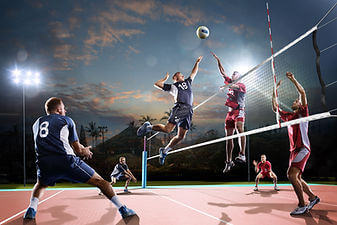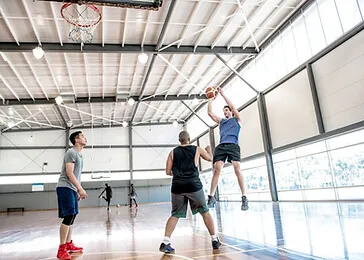Do you play a jumping sport such as volleyball, basketball or AFL? Have pain in the front of your knee when jumping, landing or changing direction? Have you lost some jumping power recently? Well read on friends as you may have a grumbly knee tendon.
Summary:
- Patellar tendinopathy is summarised clinically as pain and dysfunction in the patellar tendon
- Most commonly affects jumping athletes from adolescence to early middle age.
- Return to sport can be slow with physio useful as a front line management tool
- Often requires prolonged rehabilitation centred around education, strength training and load management
Jumper’s knee (or patellar tendinopathy) as its name suggest predominantly affects athletes who engage in sports which require large volumes of jumping. Jumping dynamically loads the knee and places large loads on the patellar tendons due the large and repeated requirements of the thigh muscles (quadriceps). These include sports that require repeat jump / landing efforts and/or high volumes of load during training and competition. Elite adolescent male athletes tend to be at a higher risk, especially if you play volleyball.

Like most injuries, patellar tendinopathy reflects an overload of the tissue and a failed healing response. Tendons tend to most susceptible to long periods of dynamic loading given their role in storing and releasing energy like a spring. The stiffer the spring, the more effective the spring and the more punishment it can take before the function deteriorates.
This injury is one that can be mild or moderate in nature and as such allow playing to some degree. As such, player’s tend to not to miss a lot of games like more “traditional” injuries such as ankle sprains or hamstring tears. It can typically slowly present and have a “warm up phenomena” (as in it can get better during a game), however aches after activity and the next morning. The pain is often at the very bottom of the knee cap, and on the space between the kneecap and the top of the shin bone where the tendon lies.
Key management strategies include ensuring the correct diagnosis and an understanding of tendon pathology (for more on tendon pathology, check out this blog). From there, pain management strategies and workload management is a key tenant to rehabilitation. Above and beyond workload management and good patient education, we at Praxis Physio also test the strength and range of the hip, knee and ankle musculature as well as jumping / landing biomechanics to understand where the likely reasons are for your knee pain.
After a comprehensive assessment, targeted and graduated strengthening is provided. The premise of these early phases are to reduce pain, improve strength, improve function, increase power (specifically the energy storage potential of the tendon) then finally sports specific training and management on symptoms.
As someone who has had an 18 month history of patellar tendinopathy, I personally can attest to the frustration this injury provides. I made many mistakes along my rehabilitation journey – though this was before I was a physiotherapist and took a clinical interest in tendinopathies. Thankfully, the research has come a long way in the last decade, so if you are having ongoing knee pain that you suspect is jumper’s knee, book in with us so we can get you jumping back to your best.
Until next time, Praxis what you Preach.
Stephen Timms

